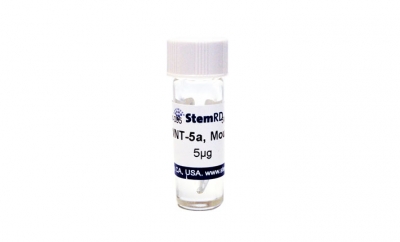| Source | M.W. | ~45 kDa | CAS No. | ||
|---|---|---|---|---|---|
| Structural Info | |||||
| Formulation | Lyophilized in sterile filtered solution of PBS with 2% CHAPS | ||||
| Reconstitution | Before reconstitution, we recommend a brief spin to drive down any material dislodged from the bottom of the tube. The lyophilized protein should be reconstituted in sterile H2O to a concentration of 100 ng/uL. Because of the hydrophobic nature of this protein, further dilutions should be made in buffer or medium containing carrier proteins, such as albumin or serum. | ||||
| Stability | The lyophilized protein is stable for at least 1 year if stored at -80 °C. Reconstituted protein is stable for at least 1 month at 4 °C, but should be stored in aliquots at -80 °C for longer term. Avoid repeated freeze and thaw. | ||||
| Purity | Greater than 85% as determined by SDS-PAGE and HPLC analysis | ||||
| Biological Activity | The activity was determined by using a TCF reporter gene assay in 293 cells co-transfected with Frizzled-4 and LRP-5. WNT-5a activates (instead of inhibits) the TCF reporter gene in this assay. | ||||
| Country of Origin | USA | ||||
WNT-5a belongs to the class of WNT proteins that activate the “non-canonical” pathway. The predicted size of mouse WNT-5a is a monomeric protein containing 356 amino acid residues. Due to glycosylation, it migrates at an apparent molecular weight of ~45 kDa by SDS-PAGE analysis under non-reducing conditions. StemRD’s product is expressed from a mouse cell line, and purified with a proprietary process that is distinct from the published method.
Ishida-Takagishi M, Enomoto A, et al., The Dishevelled-associating protein Daple controls the non-canonical Wnt/Rac pathway and cell motility. Nature Communication. 2012 May 29;3:859
http://www.ncbi.nlm.nih.gov/pubmed/22643886
Nakamuta S, Funahashi Y, Namba T et al., Local application of neurotrophins specifies axons through inositol 1,4,5-trisphosphate, calcium, and Ca2+/calmodulin-dependent protein kinases. Science Signal. 2011 Nov 15;4(199):ra76.
http://www.ncbi.nlm.nih.gov/pubmed/22087032
http://www.ncbi.nlm.nih.gov/pubmed/22643886
Nakamuta S, Funahashi Y, Namba T et al., Local application of neurotrophins specifies axons through inositol 1,4,5-trisphosphate, calcium, and Ca2+/calmodulin-dependent protein kinases. Science Signal. 2011 Nov 15;4(199):ra76.
http://www.ncbi.nlm.nih.gov/pubmed/22087032
